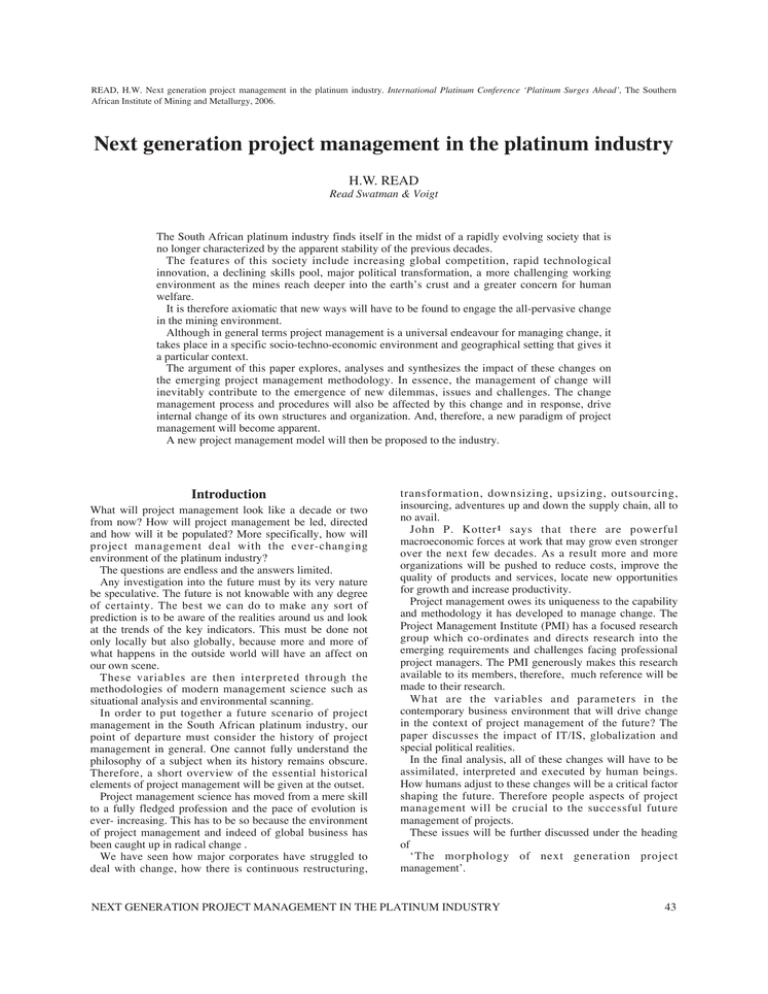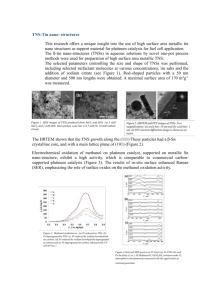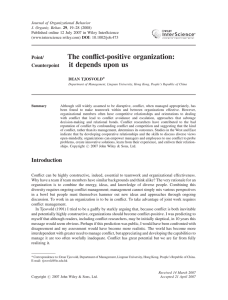International Platinum Conference ‘Platinum Surges Ahead’,
advertisement

READ, H.W. Next generation project management in the platinum industry. International Platinum Conference ‘Platinum Surges Ahead’, The Southern African Institute of Mining and Metallurgy, 2006. Next generation project management in the platinum industry H.W. READ Read Swatman & Voigt The South African platinum industry finds itself in the midst of a rapidly evolving society that is no longer characterized by the apparent stability of the previous decades. The features of this society include increasing global competition, rapid technological innovation, a declining skills pool, major political transformation, a more challenging working environment as the mines reach deeper into the earth’s crust and a greater concern for human welfare. It is therefore axiomatic that new ways will have to be found to engage the all-pervasive change in the mining environment. Although in general terms project management is a universal endeavour for managing change, it takes place in a specific socio-techno-economic environment and geographical setting that gives it a particular context. The argument of this paper explores, analyses and synthesizes the impact of these changes on the emerging project management methodology. In essence, the management of change will inevitably contribute to the emergence of new dilemmas, issues and challenges. The change management process and procedures will also be affected by this change and in response, drive internal change of its own structures and organization. And, therefore, a new paradigm of project management will become apparent. A new project management model will then be proposed to the industry. Introduction What will project management look like a decade or two from now? How will project management be led, directed and how will it be populated? More specifically, how will project management deal with the ever-changing environment of the platinum industry? The questions are endless and the answers limited. Any investigation into the future must by its very nature be speculative. The future is not knowable with any degree of certainty. The best we can do to make any sort of prediction is to be aware of the realities around us and look at the trends of the key indicators. This must be done not only locally but also globally, because more and more of what happens in the outside world will have an affect on our own scene. These variables are then interpreted through the methodologies of modern management science such as situational analysis and environmental scanning. In order to put together a future scenario of project management in the South African platinum industry, our point of departure must consider the history of project management in general. One cannot fully understand the philosophy of a subject when its history remains obscure. Therefore, a short overview of the essential historical elements of project management will be given at the outset. Project management science has moved from a mere skill to a fully fledged profession and the pace of evolution is ever- increasing. This has to be so because the environment of project management and indeed of global business has been caught up in radical change . We have seen how major corporates have struggled to deal with change, how there is continuous restructuring, transformation, downsizing, upsizing, outsourcing, insourcing, adventures up and down the supply chain, all to no avail. John P. Kotter 1 says that there are powerful macroeconomic forces at work that may grow even stronger over the next few decades. As a result more and more organizations will be pushed to reduce costs, improve the quality of products and services, locate new opportunities for growth and increase productivity. Project management owes its uniqueness to the capability and methodology it has developed to manage change. The Project Management Institute (PMI) has a focused research group which co-ordinates and directs research into the emerging requirements and challenges facing professional project managers. The PMI generously makes this research available to its members, therefore, much reference will be made to their research. What are the variables and parameters in the contemporary business environment that will drive change in the context of project management of the future? The paper discusses the impact of IT/IS, globalization and special political realities. In the final analysis, all of these changes will have to be assimilated, interpreted and executed by human beings. How humans adjust to these changes will be a critical factor shaping the future. Therefore people aspects of project management will be crucial to the successful future management of projects. These issues will be further discussed under the heading of ‘The morphology of next generation project management’. NEXT GENERATION PROJECT MANAGEMENT IN THE PLATINUM INDUSTRY 43 Finally, the conclusion will summarize the main points and make appropriate recommendations. Historic overview of project management The roots of project management can be traced back to the obscure past when large construction projects were first undertaken. One only has to think of the establishment of megaprojects such as Noah’s ark, the pyramids, the organization of agricultural land, and in more modern times, the Suez and Panama canals. In the 1870s the United States of America also built the transcontinental railway. These are just a few random examples of projects, but the first structurally organized projects have to be the many great wars fought by the nations of the world. From the strategies and tactics used in these wars arose the operational transactions which were later translated into structured project management principles. As a formal managerial discipline, project management is still relatively young2. Scientific management principles laid down by Frederich Taylor in the early part of the twentieth century together with his contemporary, pioneer Henry Gantt’s sequential activity bar charts, form the foundations of modern project management. The theory of work harmonization was developed from their research in conjunction with the work of the Pole, Krol Adamecki. This theory was the forerunner of work flow network planning, which was to become popular 60 years later with the Critical Path Method (CPM) and Program Evaluation and Review Technique (PERT). Modern project management practice, as an organized management function is, however, predicated on the systems theory. ‘Systems Theory looks at the world in terms of the interrelatedness and interdependence of all phenomena and in this framework an integrated whole, whose properties cannot be reduced to those of its parts, is called a system’3. Herein lies the whole concept of project management. Project management must always be viewed as an integrated whole—all parts work together and this unison of activity and effort is essential to the successful outcome of any project. More projects fail because of a disintegrated and disjointed approach, than any other single cause of project failure. In short, project management abhors fragmentation, system interruption and disorganization of relationships. Therefore, in order for the business to survive, all its functional parts must work in concert towards specific goals and this is the basis of modern project management. From the 1960s to current project management practices we have seen the focal points continually changing. Concepts such as scheduling, team work, uncertainty reduction, simultaneity, adaptation, strategic focus and globalization have dominated project management attitudes4. We must conclude this section with the comment that it is a myth and misconception in the discipline of project management that all projects are the same and that project managers can use similar tools for all their project activities5. This is a simplistic view of project management and is fraught with danger. Many projects have failed because project managers and their teams have failed to understand the culture and idiosyncrasies of the environment in which their projects are happening. In reality projects differ in many ways and one size does not fit all. 44 This misconception is also the basis for this paper. Our future project management processes must take account of the cultural differences and the various environments in which the project will be executed. But let us first look at the drivers of change of our new project environment. Drivers of change The culture that we have become accustomed to has always strived to maintain the status quo. We have been taught to value balance, to maintain and achieve equality and equity. But this may be a contradiction in terms because by its very nature human society is in the process of evolution. Therefore an imbalance must exist: a driving force for change can only exist if there is an imbalance in the first place. We have to shift our perception of a static social and business structure to the perception of dynamic patterns of change. The forces underlying these dynamic patterns in the changing scene of project management are many, but we can easily identify at least three of the most striking influences: Information systems and information technology (IS/IT) Information systems and information technology are probably the highest transformational factors that project management will experience over the next generations. Technological advances are happening so rapidly that as one writes about a particular breakthrough another takes its place and makes it obsolete, having been replaced by yet another astonishing advancement. The cost of telecommunications systems is continually driven down to where many of the services provided will become free. As a prime business cost, telecommunication will become a nonconsideration, as service providers move their income stream to other targets such as soft- and hardware users. The implication is that work away from the parent organization will increase. People will be able to work from home via a direct link to the office. Telecommunications will be the great facilitator of distributed work, aided by imaging technology and computers. Researchers envisage that 40 per cent of all project work will come from distributed work by 2020. Holden and Holden 6 quote experts as saying that the practice of ‘offshoring’ (exporting IT related work from the United States and other developed countries to areas of the world where there is both political stability and lower labour costs or savings) will grow at an annual rate of 26% during the next five years. Telecommunications will make consulting services more easily available to mainstream corporates as the transactional costs, which traditionally were thought to be high, become almost non-existent. This will allow the expertise to be sourced in an optimal way from those who have capability and capacity at the opportune time. Consultants can therefore be accessed across the globe. This facility will introduce new complications for the manager of projects. With the workers dissociated in time and space from the manager, management of teams will have to be reinvented. The effect will not be uniform across all project activities and will certainly be different at various stages of the project life cycle. In the early stages of the life cycle, during prefeasibility and feasibility stages, when the emphasis will be on concept design, scheduling and estimating, the various functions can be readily integrated. During the design stage, design work can be PLATINUM SURGES AHEAD easily managed from a virtual office. The difficulties will, however, be increased during the construction stage when physical presence is a prerequisite. Management of distributed workers will be further complicated by any work across national boundaries, where workers are even further dissociated from the project manager. The project manager will require special talents and training for this new task. Gunayden and Arditi7 conducted research to assess the impact of information technologies on project management knowledge areas in the building design process over the next fifteen years. The main findings were that full maturity levels will not be reached for project management knowledge areas in the design phase of a building project. However, steady increases are expected for the project management maturity level. Another significant finding indicates that IT deployment without addressing the structural issues in the organization does nothing but create automation. It is therefore imperative that restructuring/reengineering efforts should address all aspects of process improvement. Globalization We are living in a boundary-less, worldwide community in which human performance will increasingly become the determinant of business success. Writing in the Future of Project Management, Coattes and Jarratt Inc8, divides the world into three regions: World 1— the advanced nations World 2— the nations where the populations' needs and available resources are in relative balance World 3— the countries in the worst conditions overall economically By the year 2025 the cumulative population totals will be distributed as follows (see Figure 1): World 1— ± 1.3 billion World 2— ± 5.1 billion World 3_ ± 2 billion 8.4 billion The special cases of India and China, when viewed on purchasing power parity, can distort the picture significantly. India, for example, has a middle class population larger than the whole population of Germany. World 3 2 bn (24%) World 1 will continue as the centre of the most high-tech developments and applications, the most comprehensive systems and the most advanced use of materials and technology. World 2 will be vigorously attempting to adopt as much as possible of World 1 technology within the limits of its resources. Already China, with its large store of cheap labour, has emerged as the manufacturing giant of the modern world. Using sophisticated World 1 designs and technology coupled with cheap labour, it has the potential to outstrip most of the traditional manufacturers. World 3, on the other hand, will concentrate the bulk of its project attention on infrastructure development. What are the implications for project management in this changing global scene? In the first place the intensity of projects will be dispersed across ethnic, social, cultural, religious and other boundaries. Project managers will therefore have to rely more and more on satellite teams linked across cyberspace to transfer expertise and mainly leadership and management skills to areas where this knowhow is lacking. This means that distributed work will become the norm. More and more clerical, technical and professional workers will be put outside the organization. It suggests a shift of payment for being at a particular place at particular times to payment for completing agreed tasks. Secondly, cross-cultural learning and understanding of another way of thinking and interpreting reality will be a prerequisite. Thirdly, protection of esoteric knowledge will become more and more difficult. Organizations will become acutely conscious of what is truly secret or confidential and be much more open with everything else connected with its business. Fourthly, it may now be practical for the virtual office to operate around the clock, having contact with different parts of the world at their peak working hours. The resulting improvement in the utilization of scarce resources will somewhat relieve the pressure on an already overworked few and also allow more effective use of onthe-job training for the new generation of professionals. Fifthly, education and training will rapidly increase in World 2 and World 3. They will invest heavily in funding their brightest to achieve education, training and expertise World 1 advanced nations - needs resources 1.3 bn (15%) World 2 resources in balance 5.1 bn (61%) World 1 - advanced nations - needs resources World 2 - resources in balance World 3 - under develop countries - needs Figure 1. World population distribution 2025 NEXT GENERATION PROJECT MANAGEMENT IN THE PLATINUM INDUSTRY 45 to secure future national development. Coates and Jarrett emphasize that though average education in the population overall may be rising slowly, selected world-class competitors are arising in all parts of the world. Therefore no one must believe that their current superiority in the delivery of products and services will remain unique and beyond competition. Finally, globalization will make superior leadership a first requisite for future success in the project world. Leadership will have to adapt not only to the fast growing technological advances but also to the challenges of crosscultural management and integration of distributed teams. This will require a fresh look at the qualities of leadership. Future leadership will be challenged to develop trust from remote teams, superior conflict resolution abilities, sharing leadership and, most importantly, a high level of emotional intelligence. Social, political and economic realities The modern world has seen major changes taking place in demographics, political power balances and economic growth rates. Through the interplay of these forces the quality of life in these various areas of the globe has been regulated. But the exact relation between cause and effect has perplexed social scientists even to this day. What has been established as fact, though, is that a critical level of well-being leads to a rapid reduction in birth rate and a more balanced population. Capra 9 states that ‘human societies have developed a self-regulating process, based on social conditions which results in a demographic transition from a balanced population with high birth rates and high death rates and a low standard of living, to a population with a higher standard of living which is larger, but again in balance and in which death rates are low’. Kotter10 coined the phrase ‘Broad Based Empowerment’ meaning that the hearts and minds of all members of the workforce are needed to cope with the fast-shifting realities of the business climate. The South African government has used this concept in a narrower focus to empower the historically disadvantaged black group. Thus was born the acronym ‘BBBEE’—broad based black economic empowerment. The state imposes these statutes through various acts of parliament, the most significant being: • Broad-Based Black Economic Empowerment Act No 53 of 2003 Shareholding control Skills development employment equity Preferential procurement enterprise development Corporate social developent • Employment Equity Act • Affirmative Action • Various codes of practice. The Mining Charter requires a transfer of 15% of the mining industry’s assets into historically disadvantaged South African hands within 5 years (from 2002) with a commitment to increase this to 26% by 2013. The code describes seven key elements of transformation, viz. shareholding (ownership), control, skills development, employment equity, preferential procurement, enterprise development and a residual that is normally interpreted as corporate social investment. Woolley11 demonstrates it by the pyramid in Figure 2. In broad terms the intention is to measure the transformation process through a scorecard by aggregating the weighted scores of the various indicators. How will the BBBEE affect the future of project management in the platinum industry? In the first place a new mind set will have to be cultivated among our project leaders. The much vaunted transformation will not be sustainable unless economic growth is achieved, not only in the long-term but there should also be visible short-term gains. These short-term gains will drive the goal of a stable and sustainable business. Our future thinking must embrace the African strategy of ubuntu (humaneness). Broodryk12 develops a very adequate management strategy based on the principles of ubuntu. He says ‘this style of management differs from the closed and autocratic management approach in the sense that the leader becomes part and parcel of the working team.’‘…This goes far beyond the principle of participative management’. It means that all have a say in decision-making and decisions are made only when a significant contribution has been made by the team members. Although the management style is open and free, chaos is not prescribed but rather responsible engagement of the role-players. Secondly, the principle of sharing must be communicated to all the stakeholders and the buy-in of this idea must pervade the philosophy of company strategy. To achieve the goal of sharing, complete alignment of all the roleplayers will become a non-negotiable imperative. Alignment sessions facilitated by a competent professional must be held at key milestones throughout the life cycle of the project. Alignment is especially important at the initiation of the project. Ownership 30% Attracting and retaining Indirect empowerment Residual 30% 30% 10% Figure 2. Woolley’s pyramid 46 PLATINUM SURGES AHEAD Thirdly, partnering alliances must be forged throughout the supply chain. Suppliers and receivers of products must be brought together so that understanding of each other's needs can be created, continual improvement sought and the improvement transferred to the benefit of all the alliance partners. The hierarchical model of leadership is not appropriate to project management of the future, particularly in South Africa, with its culture of ubuntu. A new kind of project management that relies on partnerships and persuasion through the value of ideas 13 must be pursued. Such partnership alliances can be achieved only when complete trust exists among the partners. Therefore, a concerted effort must be made to ensure mutual trust. Lastly, mentorship, learning and training will become all important in our new milieu of transformation. The development of our human capital is key to the success of future project management teams. Much of this development will take place on the job in the practical, real environment of executing the project. To this end it will be incumbent on experienced professionals to pass on their knowledge through structured mentorship and coaching programmes. This can best be achieved under the guidance of skilled facilitators and consultants. Project management is a lifelong learning experience and all team members should be made fully aware of this imperative. No one should think that experience alone will be the paragon of continuing excellence. Experience and theory, continuously updated, will be the only way that an incumbent will remain at the edge of the profession. Morphology of next generation project management The rapidly changing environment that we have examined will continue relentlessly to change at an ever-increasing pace. It is therefore obvious that an entropy of project management needs to be developed that will increase the probability of the successful outcome of projects. Of all the variables involved in this changing process, none are more important than people. The human factor will dominate project success even more than in the past. When we synthesize the elements of project management systems, methodologies, processes, procedures and practices, economic drivers and equipment and plant we find that the one element that has the highest resistance to change is the human psyche. Human psychological make-up inherently seeks stability, a stability that cannot be found in the dynamics of a changing world . Project management is a knowledge-based activity that is typically practised by well-educated professionals and supported by professional associations. While much of the work done in the last 35 years has aimed to improve the practice of project management, it continues to deliver disappointing results. Mengel and Thomas14 suggest that this is because the formal development of project management knowledge has focused on only one of the three ‘kinds’ of intelligence that are required to manage complex and uncertain projects. Our next generation project management with its more rapidly changing environment, distributed work requirement, cross-cultural workforce and highly unstable work environment will put even greater emphasis on the emotional maturity of its leaders and managers. Daniel Goleman 15 argues that complete cognitive intelligence must also include a component that measures the emotional capacity of the human subject. He calls this factor emotional intelligence or EQ. Mengel and Thomas place14 EQ as the most influential factor in distinguishing between high and low performance in management and leadership. Tjosvold and Tjosvold16 regard psychological insight and skills as an indispensable component of our future business leaders. Project leaders and managers of the new breed will find the informal, casual, traditional way of acquiring psychological acumen to be inadequate and sometimes counter-productive when ineffective ideas are used to reinforce biases. Mengel and Thomas 14 quote research undertaken by Goleman in 500 companies in order to identify the factors most influential in the organization’s performance. These findings confirmed earlier research indicating that ‘in an environment of rather high IQ, technical skills and cognitive capabilities were of rather low differentiating importance compared to emotional intelligence factors. Hence while IQ seems necessary for professionals to do their job decently, EQ competencies are the ones that seem to make them ‘excel’. Mengel and Thomas 14 put these concepts neatly into context: ‘The major anthropological assumption appears to be a perspective on human beings as being a rational, information-processing and problem-solving species, however, philosophers and psychologists have continuously rejected the notion of intellectual capabilities being the only or most important characteristics differentiating human existence from other species’. Furthermore, the search for human values and meaning is the primary motivation of the human existence. Steven Covey17 draws the conclusion that the real meaning of life is locked up in a sense of self, a sense of your own destiny, and sense of your unique mission and role in life. To reach this level of understanding you must engage in the whole person paradigm: heart, body, mind and spirit. Spiritual intelligence (SQ) is the central and most fundamental of all intelligence because it becomes the source of guidance of the other three. ‘Spiritual intelligence represents our drive for meaning and connection with the infinite’. Covey17 goes on to say ‘SQ also helps us discern true principles that are part of our conscience, which are symbolised by the compass.’ The compass is an excellent physical metaphor for principles, because it always points north. The key to maintaining the high moral authority is to continually follow ‘true north’ principles. We are now ready to explore guidelines for establishing the morphology of project management in the next generation. Guidelines for the new model Project management has been grounded on very sound principles and has continuously grown into a sophisticated profession that is recognized across the globe. This body of knowledge is diligently maintained by the Project Management Institute which, through its vigorous research programmes into knowledge and practices, ensures that both theory and practice remain at the cutting edge. This research will further ensure that the five process groups and nine knowledge areas as defined by ‘A Guide to the Project Management Body of Knowledge (PM Bok Guide)’ will remain relevant to the future project management teams. The series of standards created by the European Union— ISO 9000 and ISO 14000, are becoming universally accepted. One can expect this position to continue. Governments and managerial organizations will continue to use and update these standards. NEXT GENERATION PROJECT MANAGEMENT IN THE PLATINUM INDUSTRY 47 There will, therefore, be no strong justification for creating new models for the management of projects. What we do have to contemplate is the development and characteristics of project leaders of future project teams. From the text of this paper a main theme has become apparent. The project environment has dramatically changed over the last several years and the pace of change will increase in the next generation. Science and technology are driving change in all areas of the project endeavour. IS/IT is perhaps the area most affecting the change, although there has also been dramatic change in the areas of business science, operational research, engineering plant and process methodologies and the human sciences. It will not be possible for individuals to become competent in more than one discipline or sub-discipline. The days of multi-skilling at a professional level have been effectively relegated to the distant past. This is the era of specialization. It is hardly conceivable that a project team can operate without an IS/IT specialist to design and coordinate the multitude of communication links required for distributed teams; a business analyst to maximise the value the project will deliver to the organization; professional engineers in every discipline and sub-discipline the project may require; public relations/media specialists to protect project teams from distributing convoluted and distorted messages to the outside world; specialist managers in project support roles and other specialists such as marketers, research and development, scientists, risk managers and security enforcers, etc. depending on the projects orientation and setting. Furthermore, to prepare for success, specialists will have to be engaged to guide our transformation programme. This is a particularly a sensitive issue that will require delicate yet firm leadership to seamlessly integrate the different cultures into the project management environment. It should not be tackled on a basis of expediency but rather regulated by a continuous economic value-added process. In-depth technical, managerial and business training fully supported by on-the-job mentorship and coaching must underpin the process. Truncation of this process in any way will have severe consequences not only economically, but also politically. It is therefore imperative that the mentoring and coaching programme be under the overall supervision of a specialist professional. Project management services will require their leaders to become more orientated towards the well-being of the society affected by the project. People will have to be managed on the whole person paradigm. A total integration of heart, mind, body and spirit will be required to create the collaborative spirit that can make distributed teams function productively. We will therefore have to invest heavily in the development of global project leaders. They have to be taught in the words of Frances Hesselbein, executive Director of the Girl Scouts of the USA, to focus on what to be, not just on what to do. The leader of the future will have to demonstrate the personal integrity that shows that behaviour matches personal beliefs. This will be the only way that they can win trust from those of different cultural, religious and political persuasions. Next generation organizations will have to change their mind set to embrace the whole human condition. To reach this new mind set, much work will have to be based on the psychological training of the new leaders. They will have to be critically aware of the sensitivities of 48 people and their relationships. Research has clarified the debilitating confusion that working co-operatively and in conflict are opposites18. People with co-operative goals will have conflict over the best approaches to reach their goals, a fair and effective way to dividing labour and sharing the benefits of their work. Surprisingly, competitive goals underlie both escalating conflict and conflict ‘avoidance’. Applying psychological knowledge also requires common sense. The value of co-operative, open conflict does not mean that all conflict should be avoided. Knowledge that social support is critical does not mean that people must seek it all the time. Trust cannot be just extended but people together have to develop and earn it. Psychological training of all the leaders of project teams will be an advantage. This should start during the selection phase when a recognized psychological test should be used to match the different personalities so that a cohesive blend of characteristics can be achieved across all disciplines within the team. This will be a huge advantage where effective relationships and network structures are required for distributed teams. Conclusion This paper has attempted to predict the way project management will develop in the next generation, with particular reference to the platinum mining industry. Key drivers of change have been identified and these drivers are largely of a global nature. That they will affect our local industry is borne out by the concept of the shrinking global village. We are no longer isolated from mainstream developments in the international arena. Our products are marketed in all the main centres of the world; our personnel are linked through sophisticated networks that make it possible to develop human capital in and out, across these networks. Investors from all the main financial institutions as well as on an individual basis trade on our stock exchange. Therefore, what goes on in the outside world is of great concern to our industry. We have identified key drivers of change such as IS/IT, globalization and the social, economic and political impact. In the latter respect, the political change in South Africa will have a dramatic effect on how we manage projects over the next generation. A comprehensive training, coaching and mentorship programme will have to be launched and maintained to ensure that consistent value will be added to our projects, never forgetting that we will have to develop a mind set to embrace the ubuntu strategy. An alternative without it will be disastrous from both an economic and a political point of view. Our next generation project leaders will have to be more conversant with psychology on both a theoretical and practical level. They will be required to lead multi-cultural, multi-national, multi-racial, multi-political, multi-religious and multi-gender teams. Human welfare and the human condition will be key success factors in distributed teams that will be the norm of our next generation projects. Our new leaders have to continually demonstrate how psychological insight, caring for people, inspiring vision and hard work can be profitably integrated. People will be psychologically more mature, work unsupervised to a greater degree and therefore the new leader’s role will concentrate more on integration and relationship building. PLATINUM SURGES AHEAD References 1. KOTTER, J.P. Leading Change, Boston Massachusetts, Harvard Business School Press, 1996. pp. 3–16. 2. SHENHAR, A.J. and DVIR, D. Project Management Evolution: Past History and Future Research Directions, PMI Research Conference Proceedings, PMP 02. PDF, 2004. 3. CAPRA, F. The Turning Point, Bantam Books, London, 1988. pp. 42–43. 4. LAUFER, A., DENKER, G.R. and SHENHAR, A.J. Simultaneous Management, International Journal of Project Management, 1996. vol. 14, no.4, pp. 189–199. 5. SHENHAR and DVIR, D. Ibid, p. 4. 6. HOLDEN, D.L. and HOLDEN, A.D. Evolving the Paradigm: Leading Multicultural Teams, PMI 2005 Global Congress Proceedings, Toronto, Canada, 2005. 7. GUNAYDIN, H.M. and ARDITI, D. Cross-Impact Analysis of Information Technologies and Project Management Knowledge areas in the Building Design Process, Frontiers of Project Management Research, D.P. Slevin, D.I. Cleland, and J.K. Pinto (eds.), Project Management Institute, 2002. 8. THE PROJECT MANAGEMENT INSTITUTE, The 9. 10. 11. 12. 13. 14. 15. 16. 17. 18. Future of Project Management—Globalisation, Pennsylvania, Project ,1999. pp. 16–21. CAPRA, F. ibid, 1988. pp. 216–233. KOTTER. J.P. ibid, pp. 166–167 WOLLEY. R. Everyone’s Guide to Black Economic Empowerment, Johannesburg, Zebra Press, 2005. BROODRYK, J. Ubuntu Management Philosophy, Knowres Publishing, Randburg, 2005. pp. 137–150. GOLDSMITH, M., GREENBERG, C.L., ROBERTSON, A., and HU CHAN, M. Global Leadership, London, Prentice Hall, 2003. pp. 68–69. MENGEL, T. and THOMAS, J. From Know-HowTo-Know Why, A three dimensional model of Project Management Knowledge, PMI Global Proceeding, Anaheim, California, 2004. GOLEMAN, D. Emotional Intelligence, Bantam Books, London, 1997. TJOSVOLD, D. and TJOSVOLD, M.M. Psychology for Leaders, John Wiley & Sons, Inc., New York, 1995. COVEY, S.R. The 8th Habit. Simon & Schuster, New York, 2004. TJOSVOLD, D. TJOSVOLD M.M, ibid, 1995. p. 239. NEXT GENERATION PROJECT MANAGEMENT IN THE PLATINUM INDUSTRY 49 50 PLATINUM SURGES AHEAD






